Southern Morocco is where we are right now, south of the High Atlas, with the Sahara desert landscape unfolding before us. Rather looking forward to this part of the trip I have to say. I like deserts.
Reach our destination late afternoonish and are greeted at the entrance to a Berber encampment: “Assalam Alaikum”. It is all looking distinctly promising. File up the red carpet between two lanterns and under an archway. Inside are revealed twelve black tents in two rows. Long carpets line the walkways in front of them and a few trees provide shady spaces. Unquestionably a glam camp.
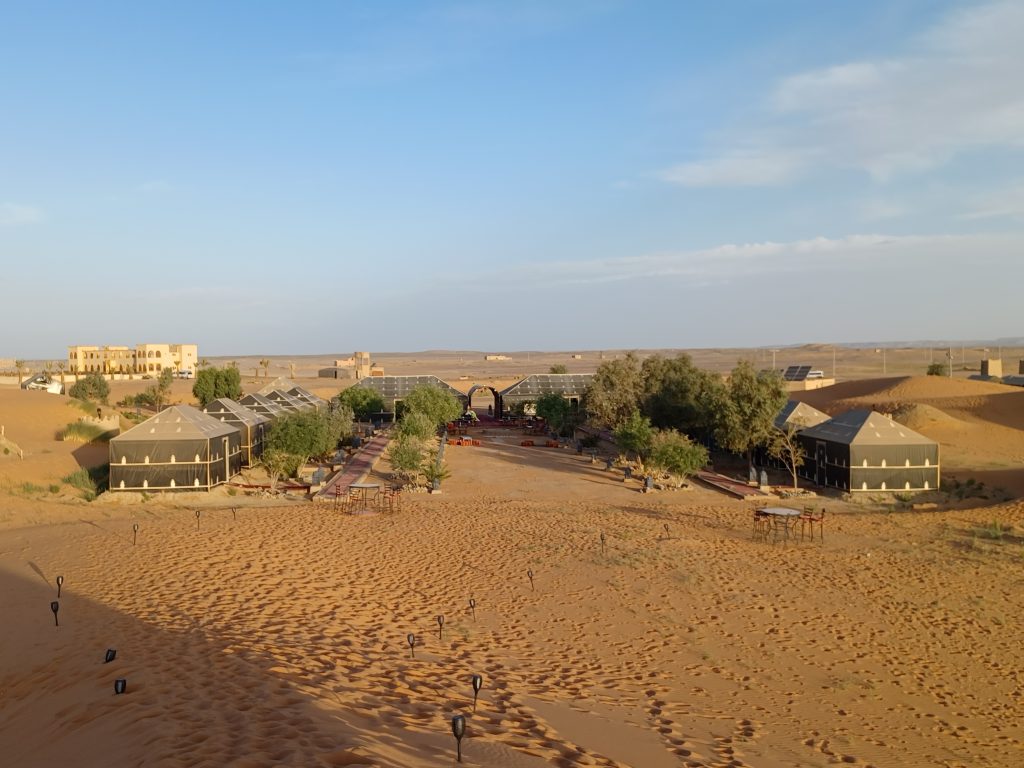
Toilet and shower are installed in each tent. In between the two rows is a patch of tables and a fire laid in a stone basin in the middle. An enormous sand dune rises behind, torches on both sides with which to lead the unwary at nightfall.
It is not far from the Algerian border here, about fifty kilometres, an area of sand dunes known as the Erg Chebbi. Around the erg are several camps set up for tourists eager to experience the desert wilderness, star gaze and all that sort of thing. All the camps are on the edge of the sand dunes, we are told, not the middle, to prevent build-up of rubbish on the pristine sands. With a view to sustainability no doubt. Seems sensible.
Anyway, sundown approaches. Time now for one of the advertised highlights of the tour: a camel trek. Scarves are wrapped around various heads, Berber style, for protection against the elements. I forgo this particular ceremony, preferring my long peaked vizor, but observe the process while sipping tea. Some slight apprehension builds up. Tea doesn’t quite brace you for such an experience. A stiff gin might better fit the bill.
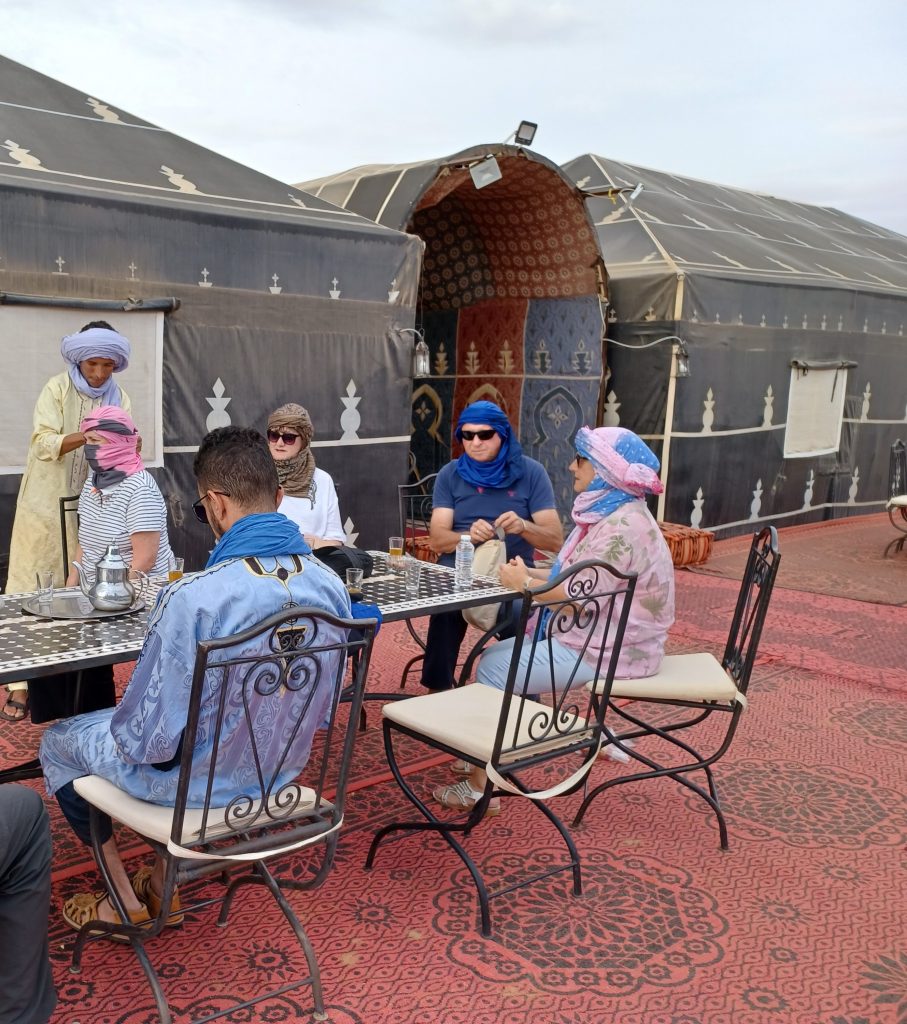
Anyhow, the camel driver beckons us outside the camp where the camels are lolling on the sand. One by one we mount. My turn. Sling my leg over the check blanket on the saddle and cling on to the metal handlebar. Under instruction. The essence of the thing is to lean back as the camel raises its back legs into the vertical position, then lean forwards as it raises its forelegs. Got that right then. All successfully mounted, the camels with their riders sally across the dunes, ofttimes floundering in soft spots, while Mohammed and Jesus run in the distance taking pictures of us all.
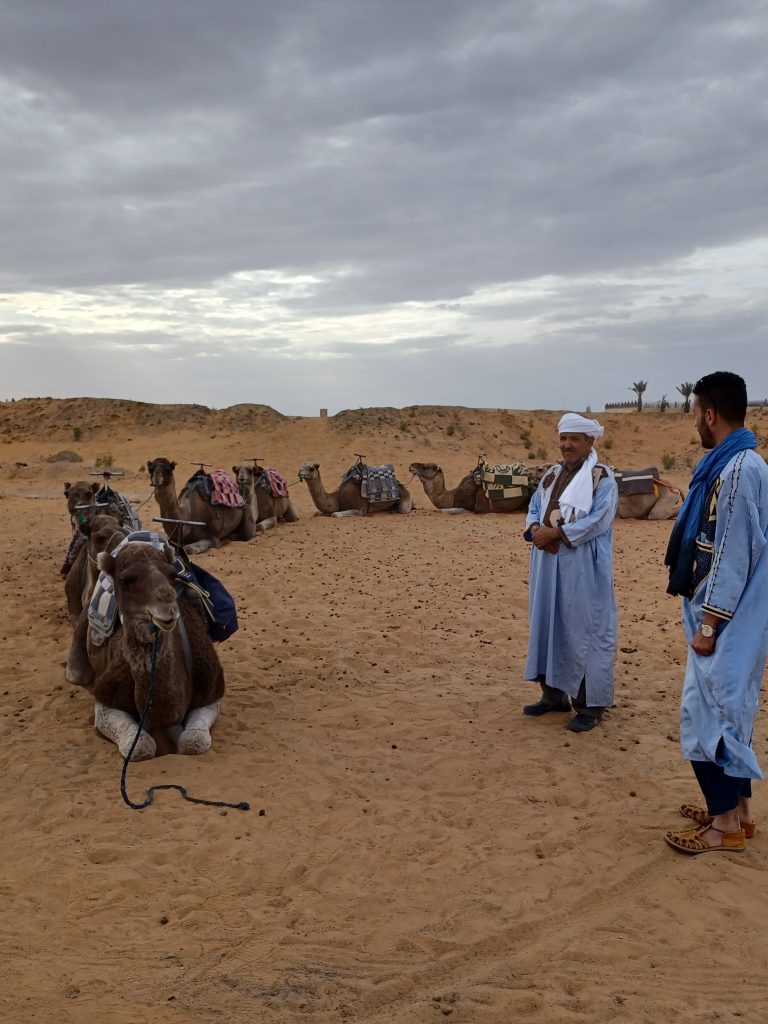
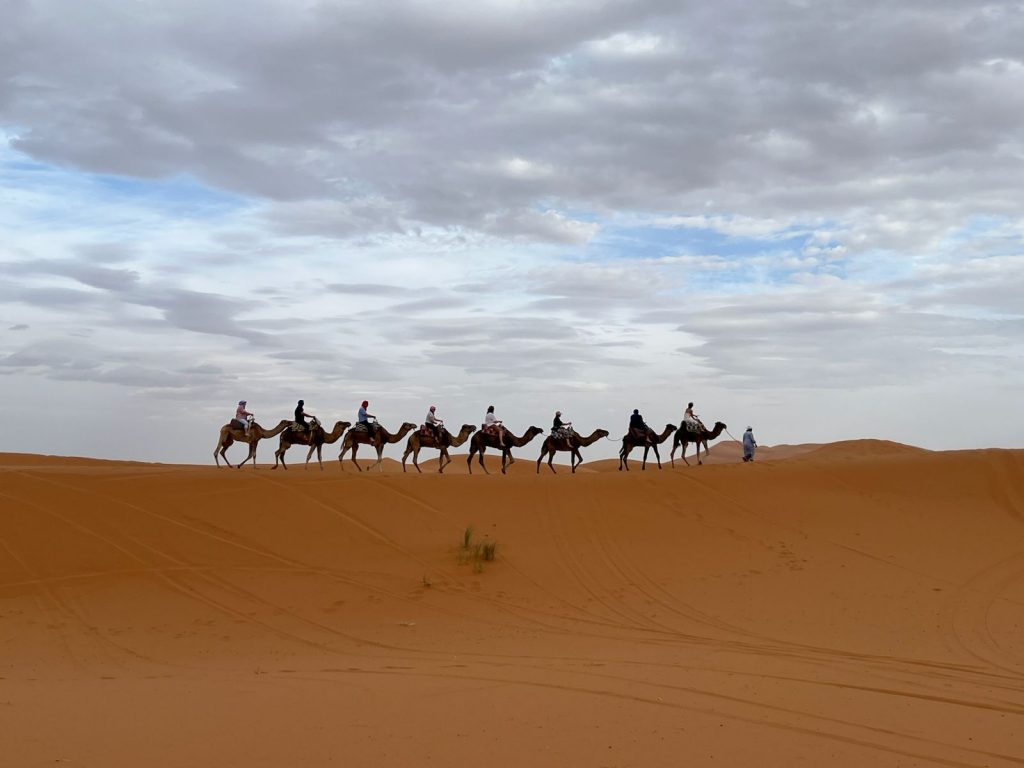
Muscles are aching a bit. Riding this beast of burden requires ceaseless vigilance, especially going downhill. While others wave with carefree abandon, I hang on to that metal handlebar for dear life. Feel myself sliding off to one side. Never was much of a one for riding horses either. Prefer bicycles. Easier to control.
Dismount at the foot of a huge dune and toil up it, two steps forward, one step backward, slipping and slithering. Feel my lack of fitness. Squat atop the dune and wait for sunset. A group of tourists on quad bikes joins the resting camels below us. In the meantime our excited Singaporean participant leaps up and down scattering sand, whilst the patient camel driver takes the perfect shot. “For my Instagram feed”, she says. It is too cloudy to view the sunset today. No matter. Slide back down the dune to remount. Slightly more relaxed now. Perambulate peacefully back to the glam camp in the gloaming.
Cracking evening ensues. Buffet and dancing and drumming round the crackling fire.
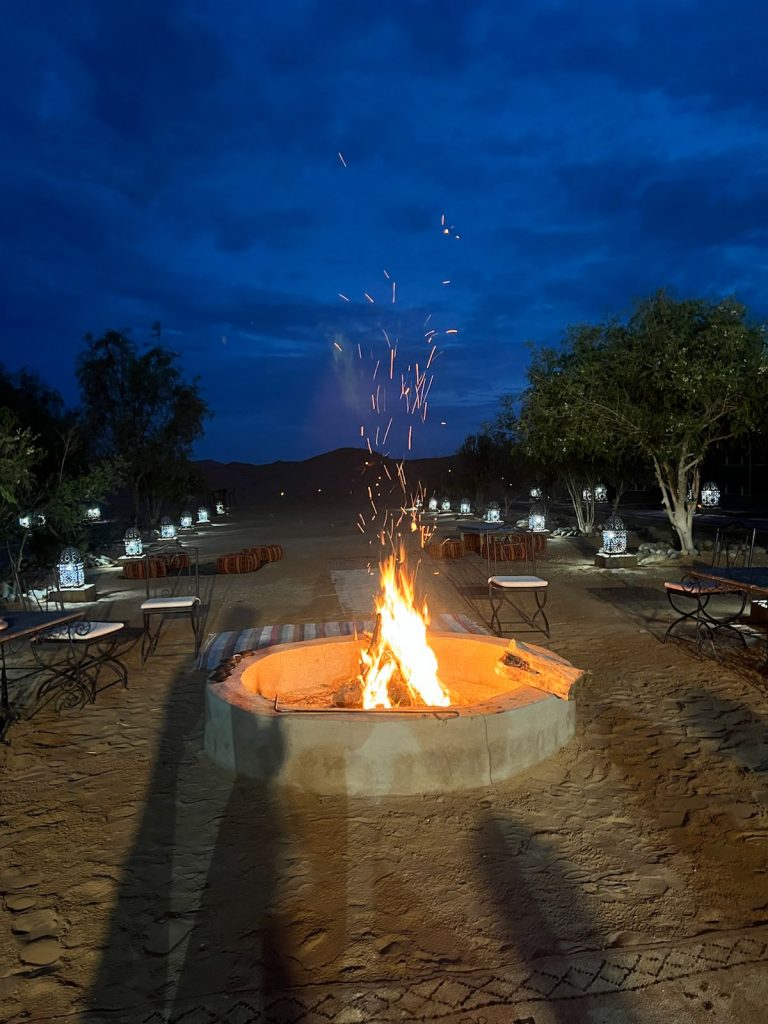
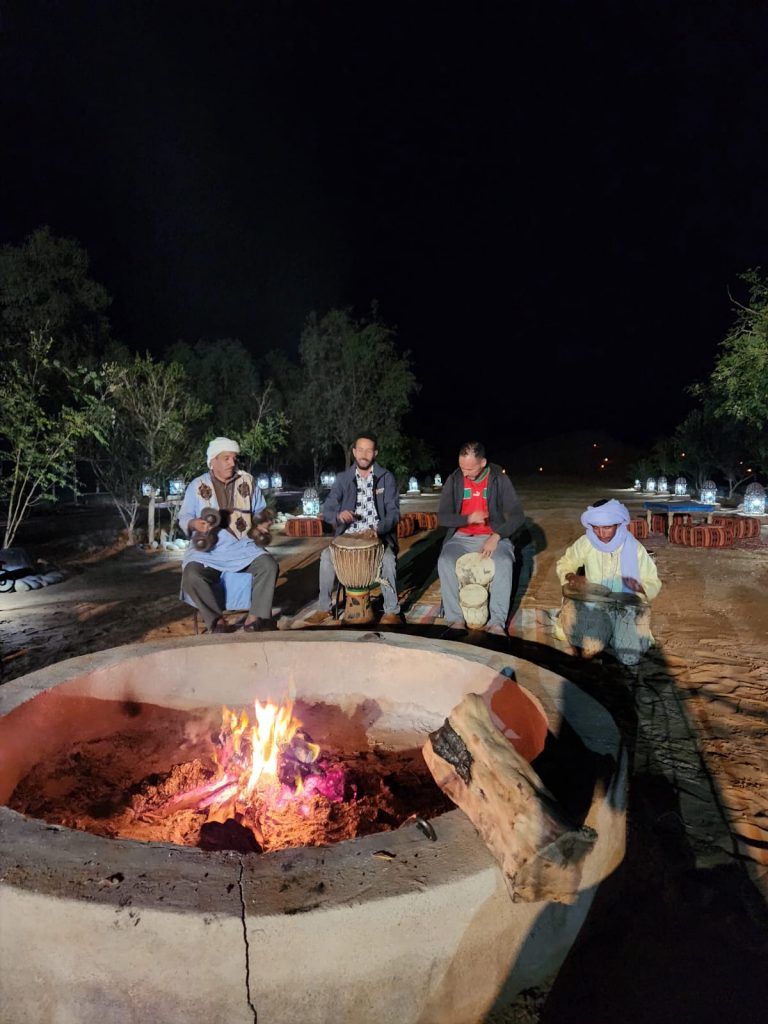
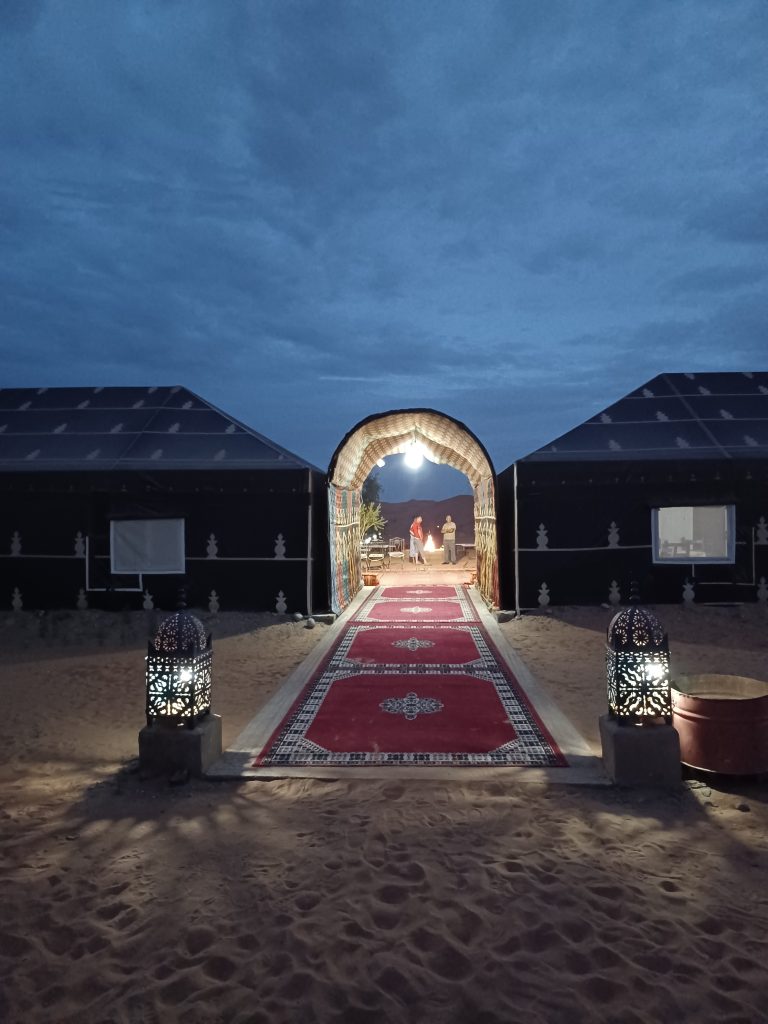
I move off after a while up the big dune with the drumming from the camp and its black tents in front, and the dunes secretive and silent, stretching behind me. It puts me in mind of one of my favourite poems by Francis Thompson:
An Arab Love Song
The hunchèd camels of the night
Trouble the bright
And silver waters of the moon.
The Maiden of the Morn will soon
Through Heaven stray and sing,
Star gathering.
Now while the dark about our loves is strewn,
Light of my dark, blood of my heart, O come!
And night will catch her breath up, and be dumb.
Leave thy father, leave thy mother
And thy brother;
Leave the black tents of thy tribe apart!
Am I not thy father and thy brother,
And thy mother?
And thou–what needest with thy tribe’s black tents
Who hast the red pavilion of my heart?
The drumming ceases. Hush falls over the camp.
It is Sunday. Surprising but I am up early for sunrise over the dunes. Spiritually uplifting and all that. Sneak into the breakfast tent. No tea so grab a coffee. Take it with me. Nip up the big dune and look over the camp as it wakens. Low sun glows yellow through the trees glancing over the footprints in the sand. Heartyish breakfast awaits. Pancakes with apricot jam, slabs of bread with cheese. More coffee.
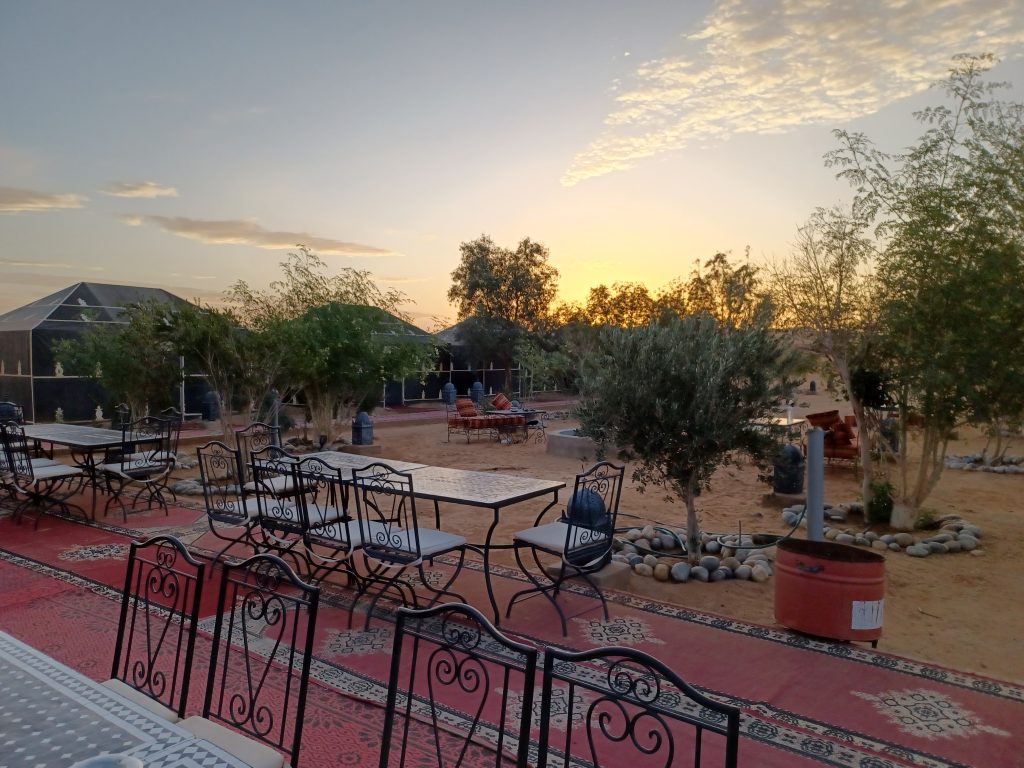
Somewhat reluctant to leave this place. Bit of luxury in the wilderness. We take our leave of the staff: “Shokran” “thank you”, load up the minibus and set off once more. Camels are wandering freely across the landscape. They only ‘work’ for about one hour each day, and then graze as they wish. Around and about are acacia trees. “They look like umbrellas,” “and make good honey.”
As we motor out over the piste, we observe a new hotel which is being built here in the Malian style, made of mud brick, plastered with whitish stuff with wooden poles sticking out of it. These act as ladders during the construction process, I gather. Looks rather bizarre. Wouldn’t mind staying in that though, when it is complete.
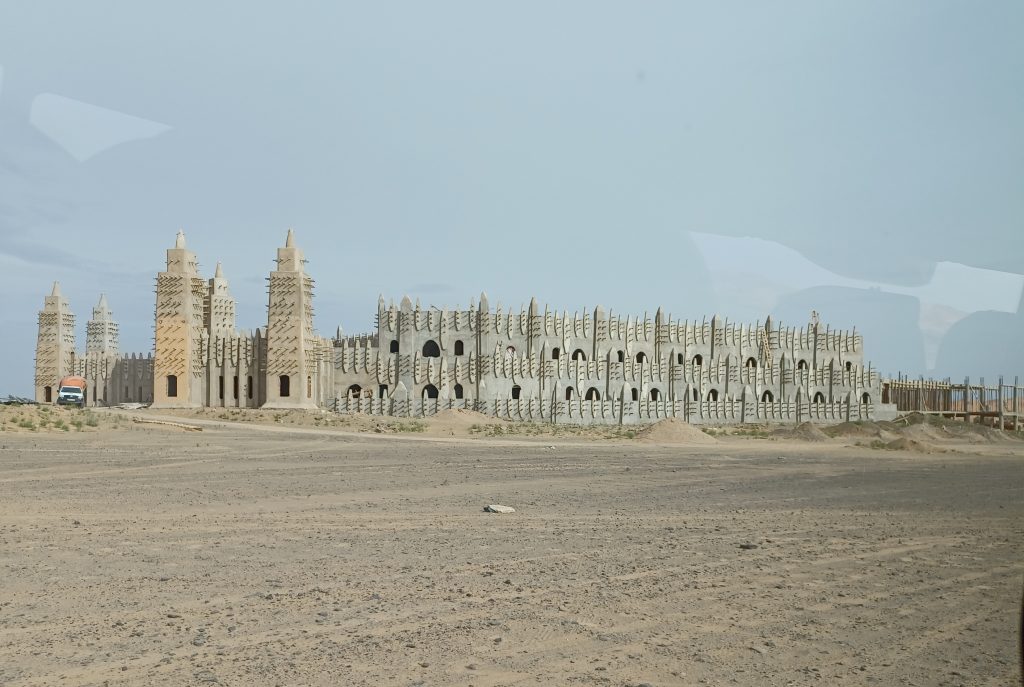
Todra Gorge
Jolly sort of morning, meandering through the sunny hills of southern Morocco. We retrace our tracks to Erfoud, then turn west past the distant mountains of the High Atlas and oases with those peachy red buildings and umpteen Moroccan flags, which are still flying everywhere after the national day on 6th November. “This is a very significant day in Morocco’s history”, we are told, after one of our number enquires as to why there are so many flags lining the streets. “The 6th of November is known as Green March Day.” King Hassan II it was who instigated the march in 1975 when around 350,000 unarmed citizens marched into the Spanish Sahara territory that Morocco claimed. “It was very peaceful.” The Spanish did not open fire and, anyway, they were about to relinquish their claims to the territory. Although Morocco did gain control over most of the then Spanish Sahara, parts remain in limbo due primarily to Algeria’s backing of the Polisario Front’s movement for independence.
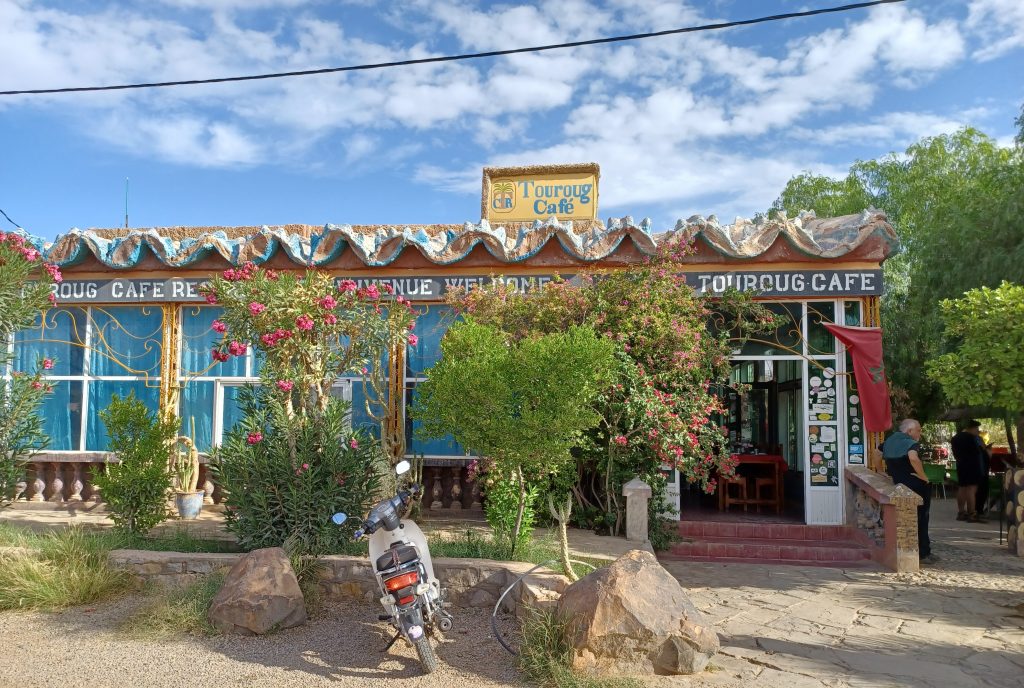
We stop for a mid-morning break at the Café Touroug. In addition to enjoying one’s coffee from a table overhung by lemon trees, one is also able to purchase an array of souvenirs. Fridge magnets and camels being the main items along with the now ubiquitous fossils.
And along the route towards the gorge are signs on rocks advertising fossil hunting treks. Eventually we approach the Todra Valley. Full of palms and patches of cultivation and ruined houses. Arrive at our Hotel Amazir for lunch. Settle round outside tables next to the turquoise pool with a backdrop of the sheer mountainsides. I opt for a Berber omelette tagine, served in a rustic earthenware dish, sprinkled with parsley. Rather good. Relax awhile.
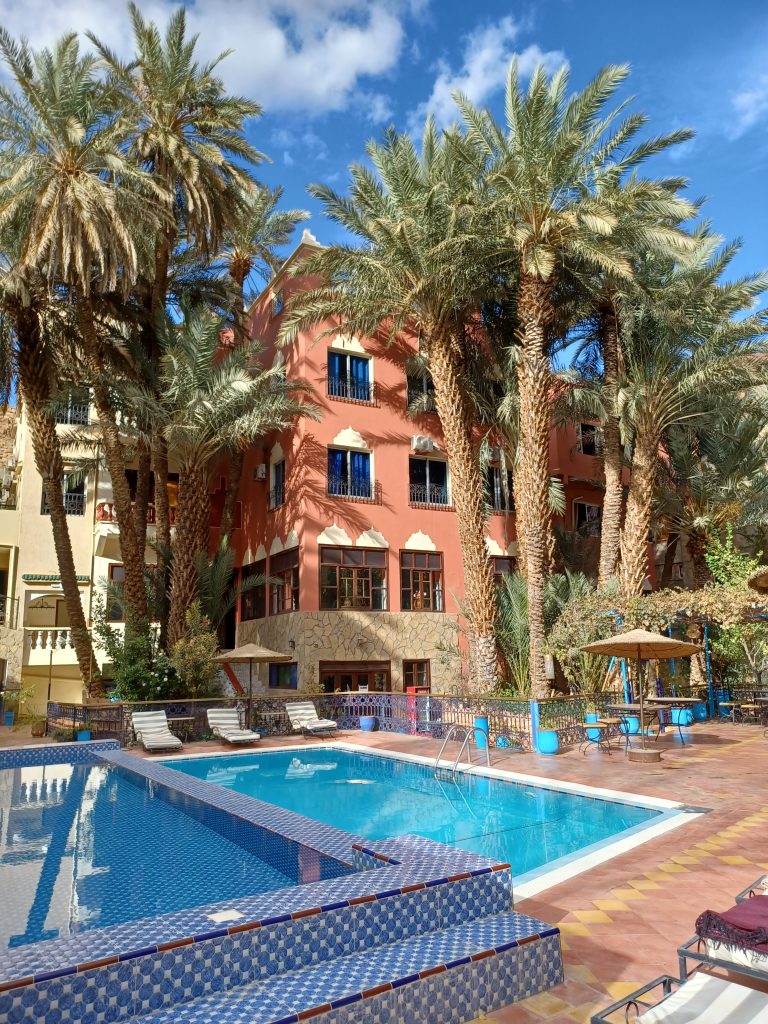
After a gentle hike behind the hotel amongst cultivated plots and twittering birds, we drive to the spectacular Todra Gorge. Dropped off at one end, we saunter between its towering walls. There is a bit of water in the stream and, apparently, trout. Some rock falls have destroyed a restaurant none too recently and some hotels, which used to be frequented, stand empty and abandoned. Nevertheless, secure in the knowledge that tourists will still pass by, traders have set up stalls selling clothes and scarves of many colours. A convoy of motor bikes passes through. Sounds loud. We emerge at the other end where our driver awaits us. No hardship on this tour.
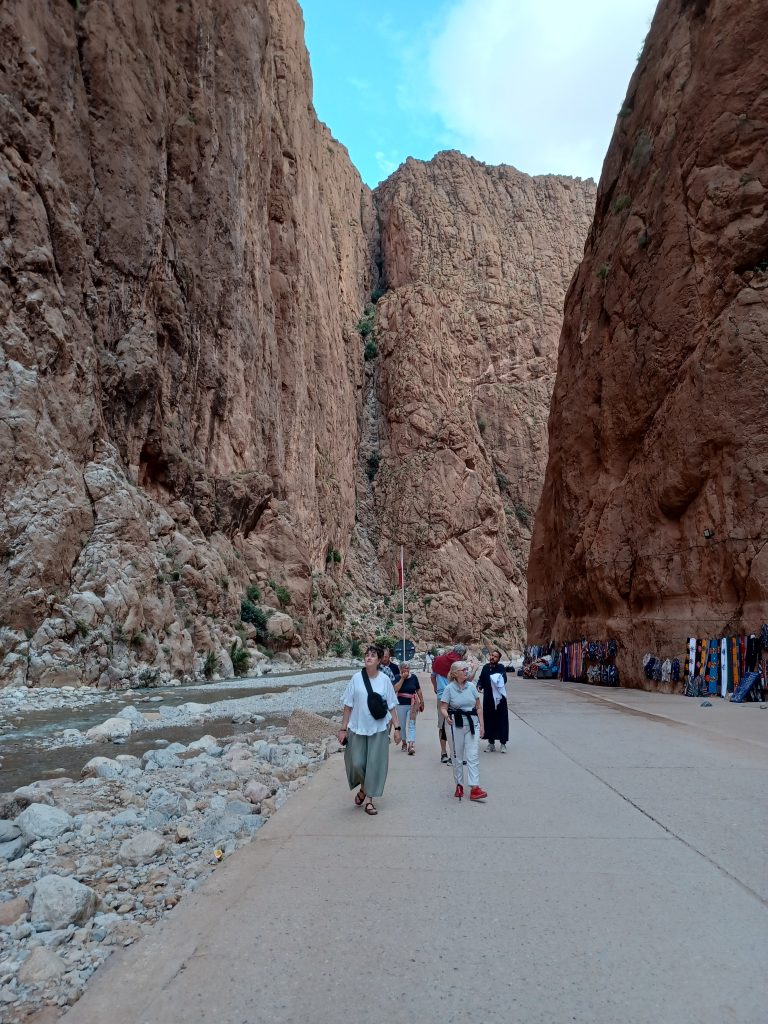
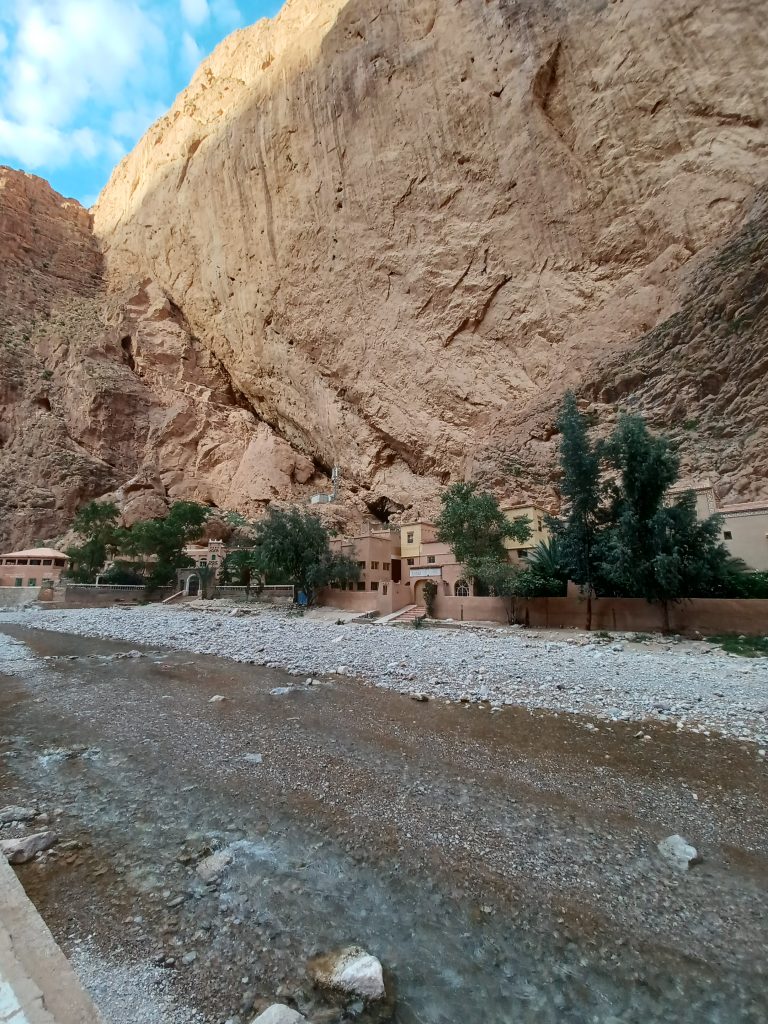
Rose Valley
Today we drive west from Todra Gorge and climb upwards into the foothills of the High Atlas. “There are no palm trees here”, we are informed. “It too cold for them. There are almonds, olives and poplars”. We continue through the Dades gorge and into the Dades Valley which specialises in rose growing and products thereof. Known as the Valley of Roses. Several thousand tonnes of roses are produced here annually.
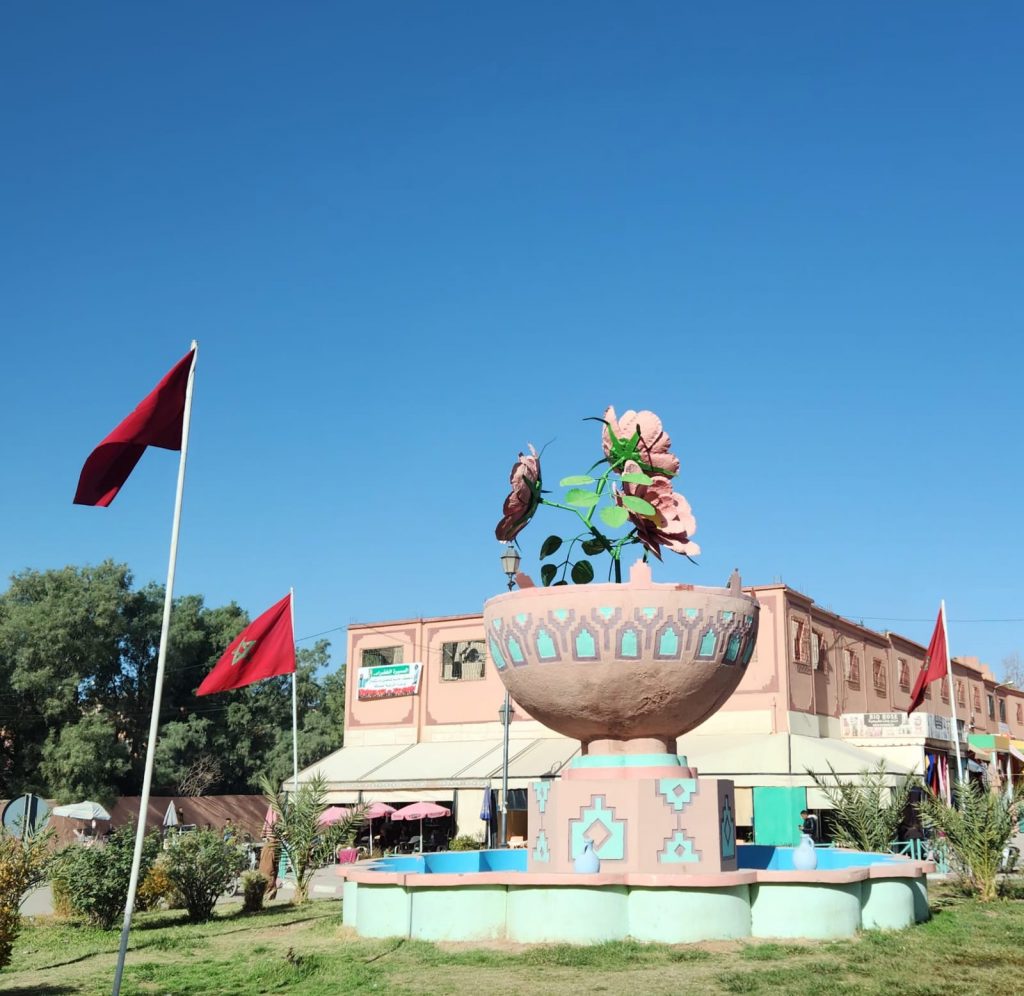
In the little village of Kalaat M’Gouna, the villagers make perfumes and sell these and other rose products from pink shops. The whole place is suffused in pink. Even the taxis. And there is a large sculpture of pink roses in a pink pot in the middle of the round-a-bout. “There is a rose festival here in May, and the people crown a Rose Queen”. We stop for refreshment in a souvenir shop selling rose soaps, rose oils, rose water…
Ouarzazate
An optional excursion, which everybody opts for, is to the Atlas Film Studios in Ouarzazate (pronounced Wazazat), the Moroccan Hollywood in the desert. A somewhat desirable location in which several film sequences have been shot including Gladiator, Cleopatra, Ben Hur and Game of Thrones. We enter and are greeted by a flickering orange neon sign welcoming visitors to ‘Ouarzawood’.
The first courtyard we enter has a life-size pair of horses and Roman chariot therein, old busses and fast cars. The first building we enter contains fixtures and fittings where would-be Cleopatras pose on a fake throne and would-be Tutankhamuns on another one. The temple is full of columns bedecked with hieroglyphs and murals of the Egyptian gods. Must have taken ages for the contemporary artists to copy those from the originals. Splendidly recreated. Spend some time admiring the decor. Our local guide, good looking chap wearing white djellaba, straw hat and wide smile, has been an extra in many films, it transpires. These include ‘Viking’ and he swipes through some photos of himself on his phone. Reckon he has a lot of fun. He explains that the town makes a considerable income from the film industry, along with tourism.
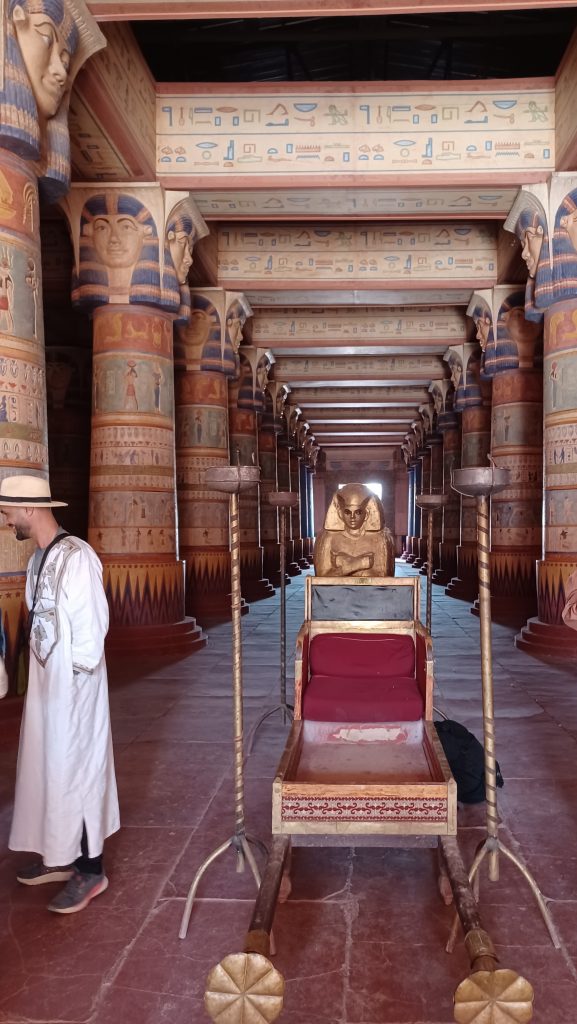
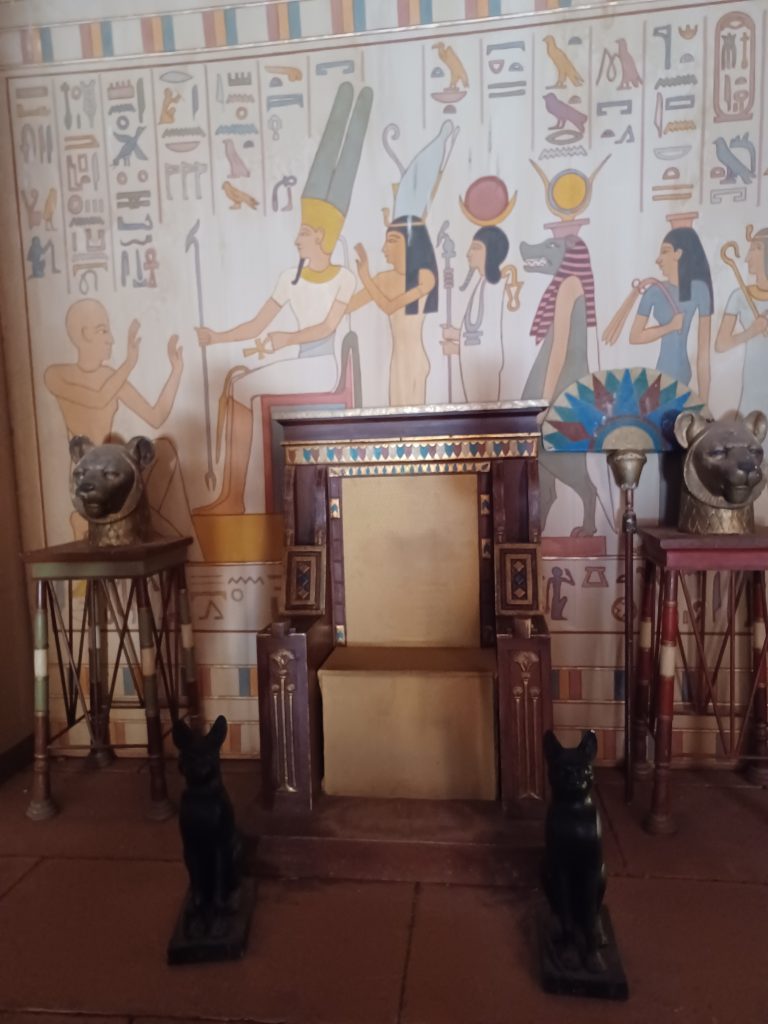
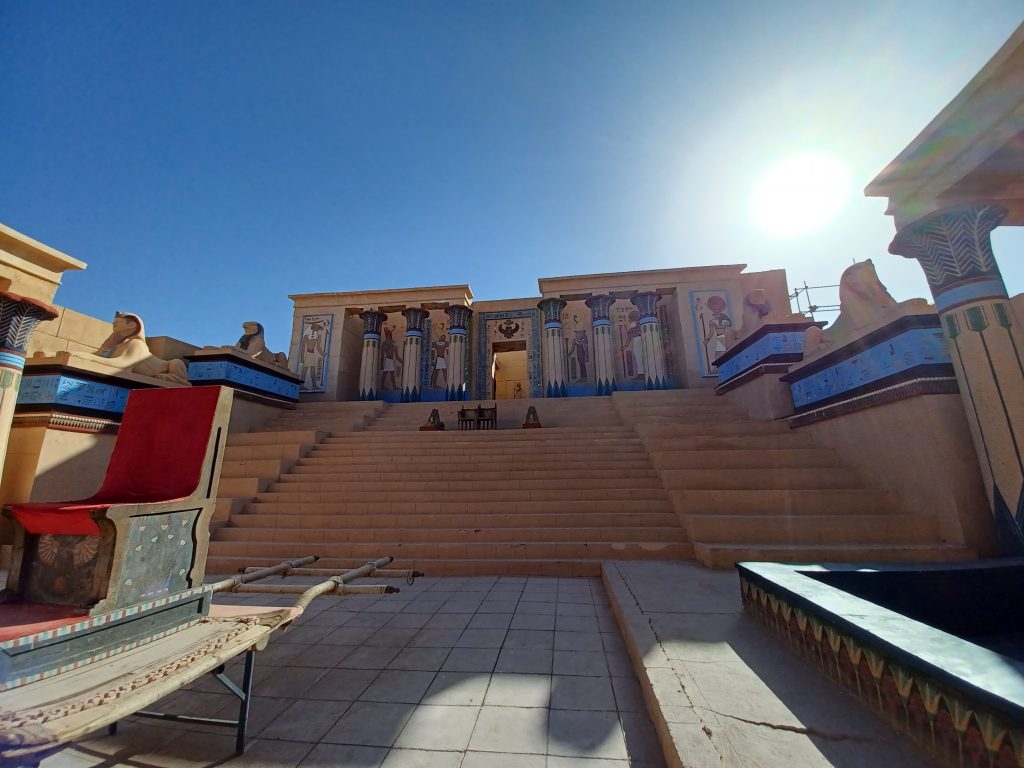
We step through an imposing doorway into Cleopatra’s palace, where another red velvet covered throne mounted on horizontal poles, like an open air palanquin, sits in the middle of a square flanked by columns and walls, flights of stairs behind and sphinxes.
There we re-enact a scene in which a few flunkeys – us – wave Cleopatra – Australian lady – to her throne. Taking no chances, the guide issues instructions to us all as to how to perform before filming the event. Cleopatra, with suitably supercilious look, makes her way between the guard of honour who ushers her in enthusiastically. No doubt our guide has shot this ‘film sequence’ hundreds of times but still seems to relish the occasion. As does our Australian Cleopatra.
Ait Ben Haddou
Ait Ben Haddou is our final stop for the day. Clever how tour planners contrive to have us finish up at spectacular sites at sunset. We walk from our hotel through part of the town and cross the bridge over the river Ounila. Not much water in it and it is a bit salty due to flowing past the silver mine up river, we are told. Rising up beyond the bridge is a large hill with a flattish top. A UNESCO World Heritage site since 1987, the ksar, or fortified village, on the hill is 16th century and was used as a stopover by caravans coming from the Sahara desert. Hence caravanserais cropped up to cater for them before they crossed the High Atlas mountains to the north. And the town grew wealthy.
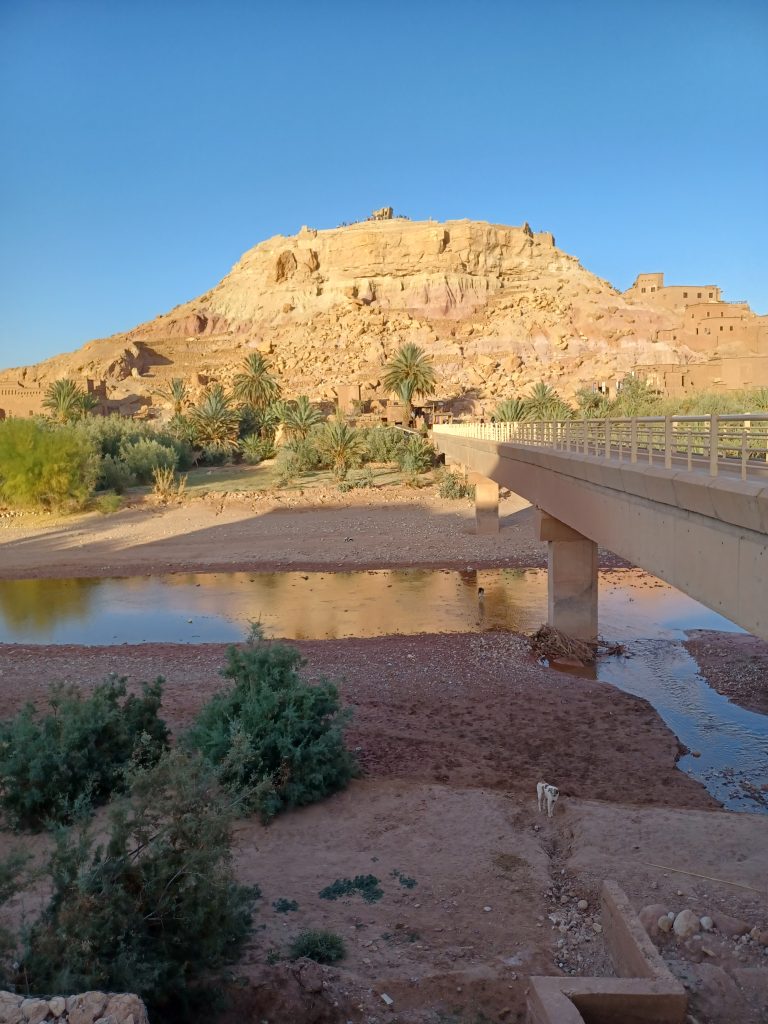
‘Ait’ means family or descendant in Berber. ‘Ben’ means of. Thus, the meaning of the name is the family of Haddou, who lived here. Today ten families reside on the hill, which has the ruins of a fortified granary on top. Protected also by guards in days of old. Many people have moved to the other side of the river now to the modern town.
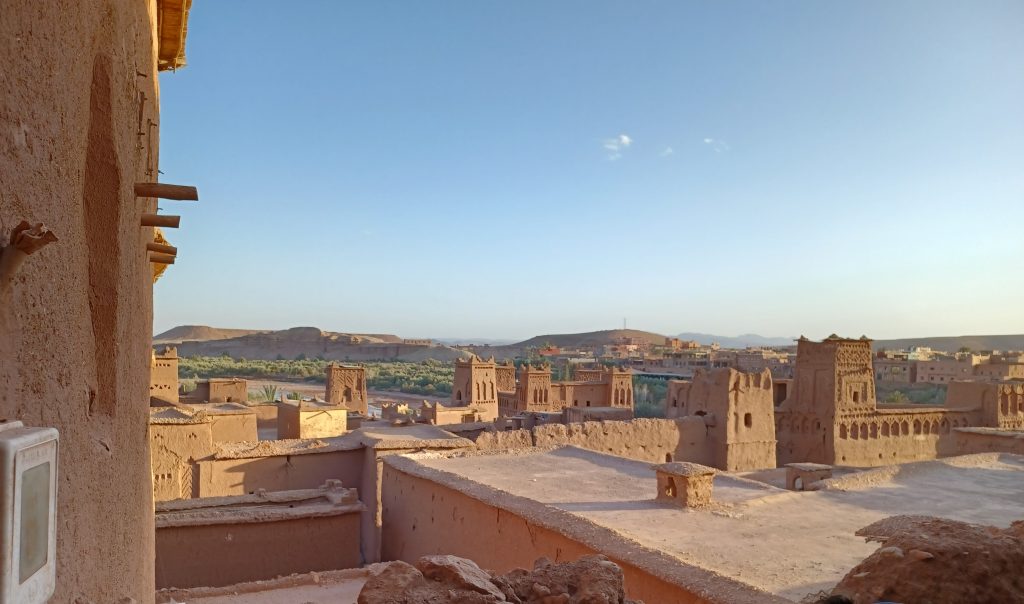
We start our walk up at 1715, only an hour or so before sunset. The path winds up zig-zag like, so not too steep, past compacted earthen buildings with bamboo roof eaves. Gabion walls have been built to support the pathways in places.
We pass through a tunnel, through the kasbah, which is built, as most taller structures here are, of compacted earth for the lower part and brick for the top and covered with a layer of clay. Emerge the other side and continue up the pathway to the granary. Stunning views over the valley. Fetchingly located for sure. From here one can look down upon a group of four kasbahs all built of the same compacted earth with stones. The architecture is traditional south Moroccan and has been preserved in keeping with its UNESCO status. The ksar is highly sought after as a film location, e.g. Alexander and Gladiator.
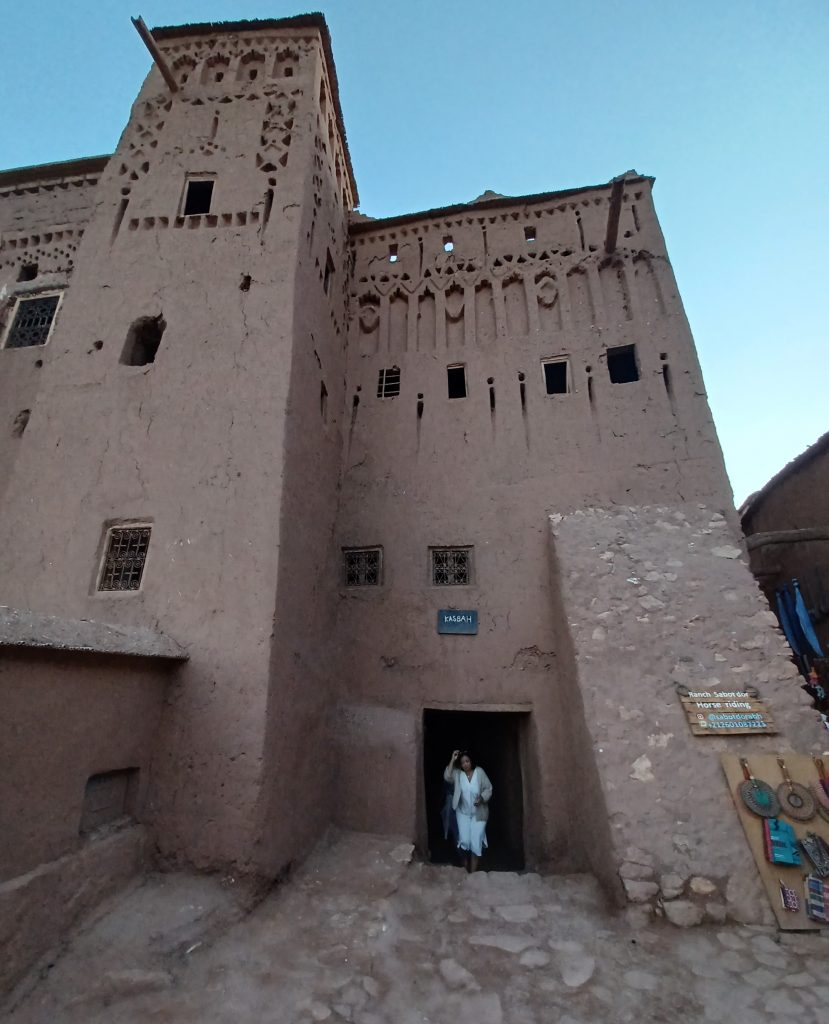
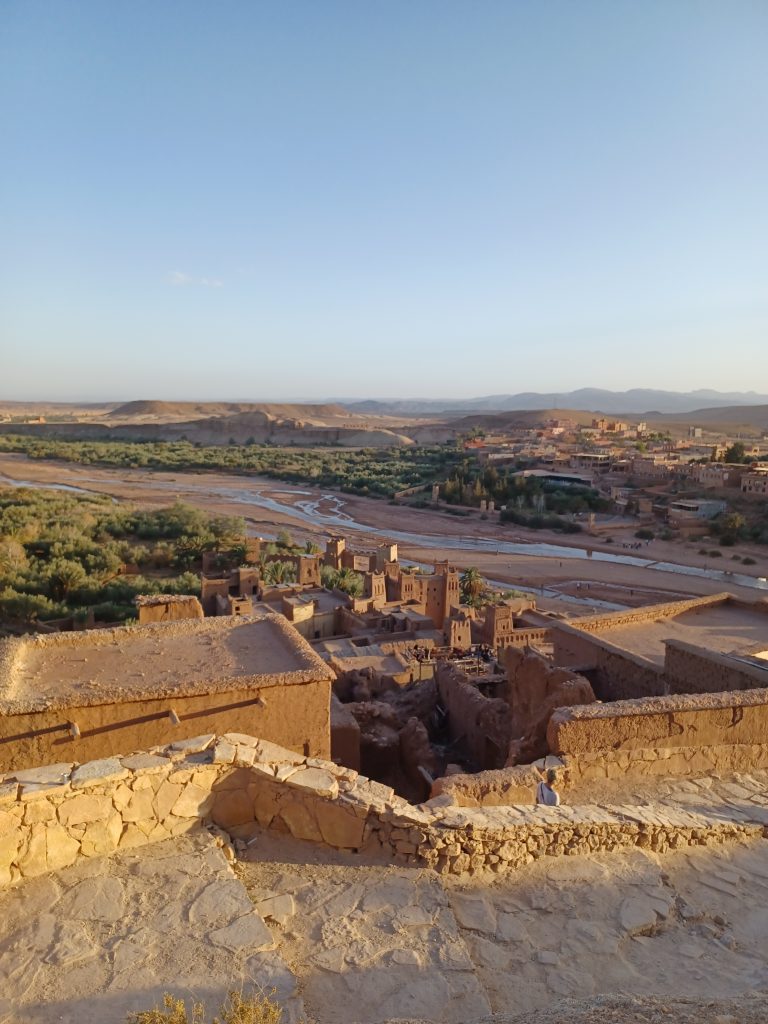
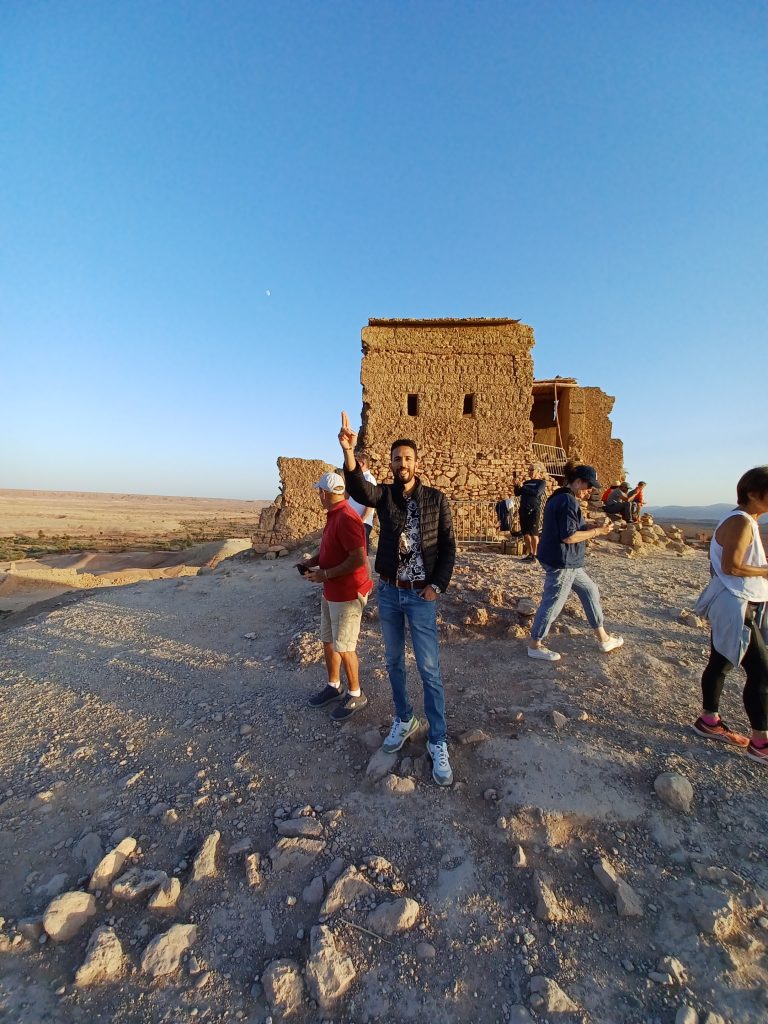
Descend the hill as the sun sets and the moon rises. On the way down, we enter a shop where a merchant is selling paintings. The artists have used tea, indigo and saffron as the painting mediums, which gives them a unique look. Further down alongside some steps is a display of fossils, rugs, ceramics and model kasbahs. Evidently for sale. A donkey with its owner emerges at the top of said steps. And at the bottom of the hill we observe the now almost unrecognisable arena used for the Gladiator set. As we exit the ksar and cross the bridge storks come home to roost atop the minaret.
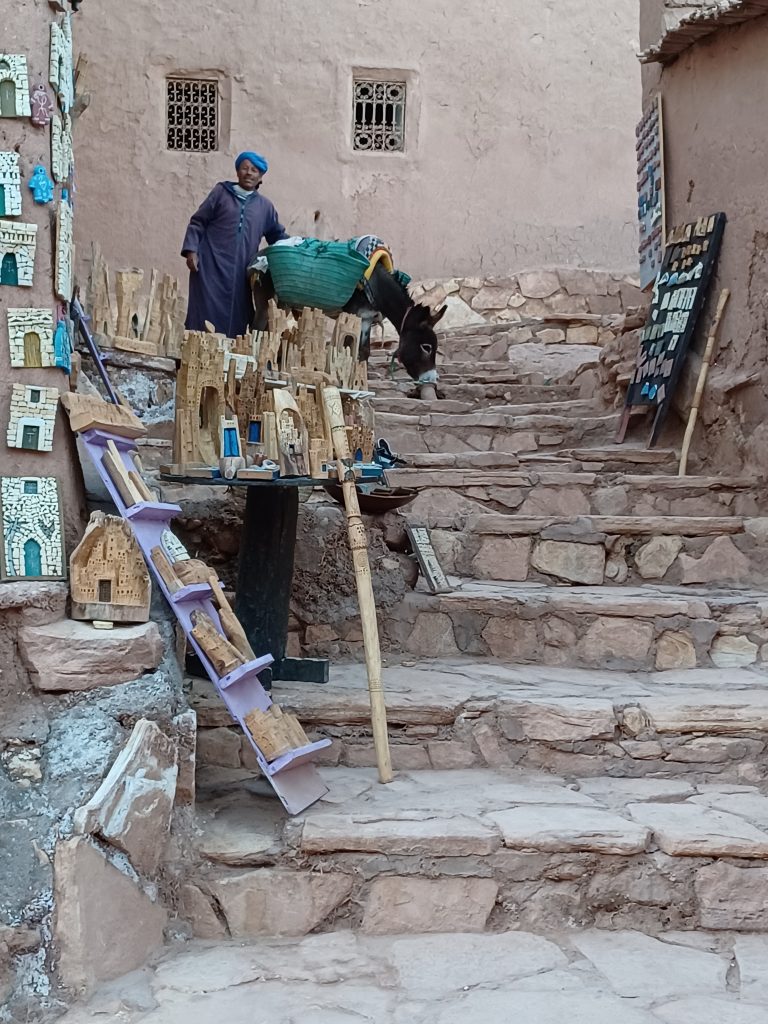
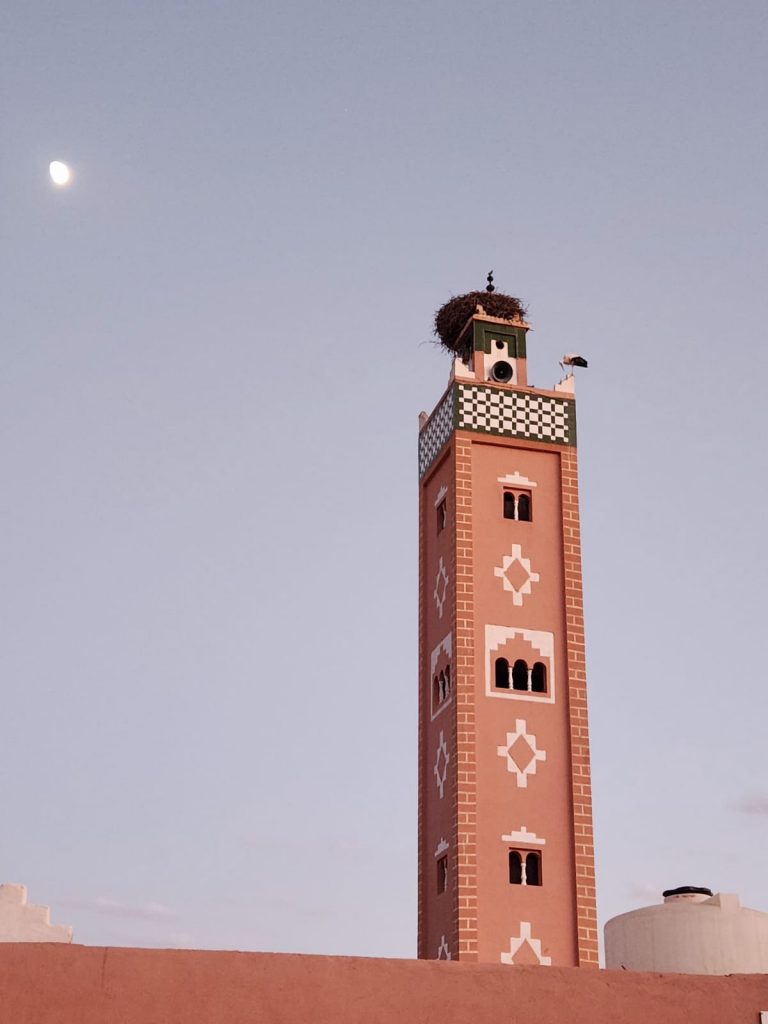
And so to eat. Another splendid buffet, this time in the La Rose du Sable hotel.
Crossing the High Atlas
A six and a half hour journey to look forward to today. Leave the lovely Rose du Sable Hotel at the ungodly hour of 0800. The caterers were somewhat tardy with the breakfast this morning, supposed to be ready at 0700 but in reality some time after that. Leave on time despite this and wind our way up sinuous roads of the High Atlas mountain range.
Palm trees disappear as we climb the hills. One stop for a ‘panoramic view’ practically blows us all away. Even there we encounter traders endeavouring to sell us souvenirs. It is freezing. Has us all running back to the comfort and warmth of the bus.
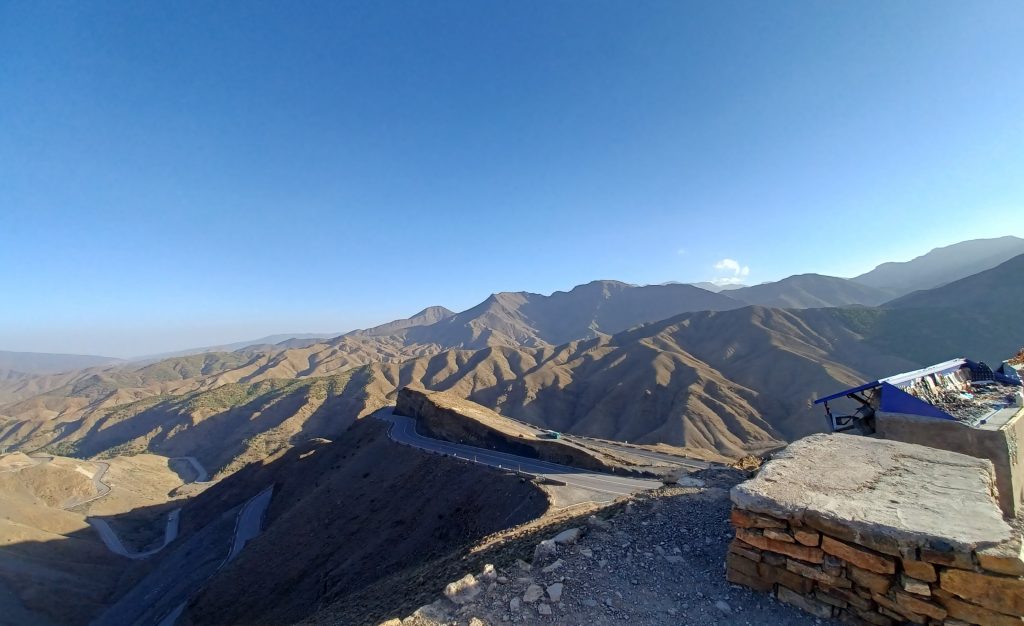
The scenery is spectacular. We pass nomads with their flocks, some on horses moving to their next camp. We are driving through the Tichka pass here, 2260 metres at its highest and over 30 miles long. Cold. Highest pass in the High Atlas and full of hairpin bends and precipitous drops. I look forwards. In the front seat thankfully. Inclined to queasiness. One of our party was carsick the other day. The road here, the Route Nationale 9, was built by the French and links Marrakech with Ouarzazate. Stop for nuss nuss (milky coffee) at an equally chilly tourist café with another splendid view.
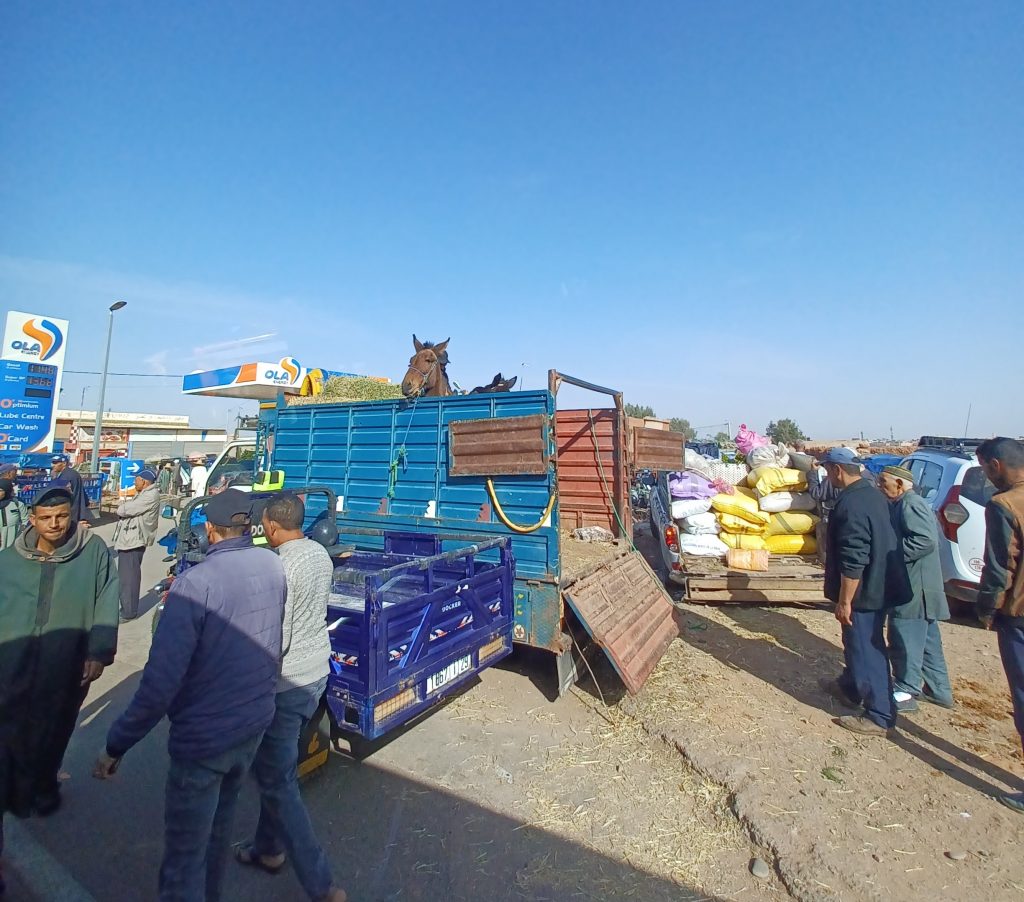
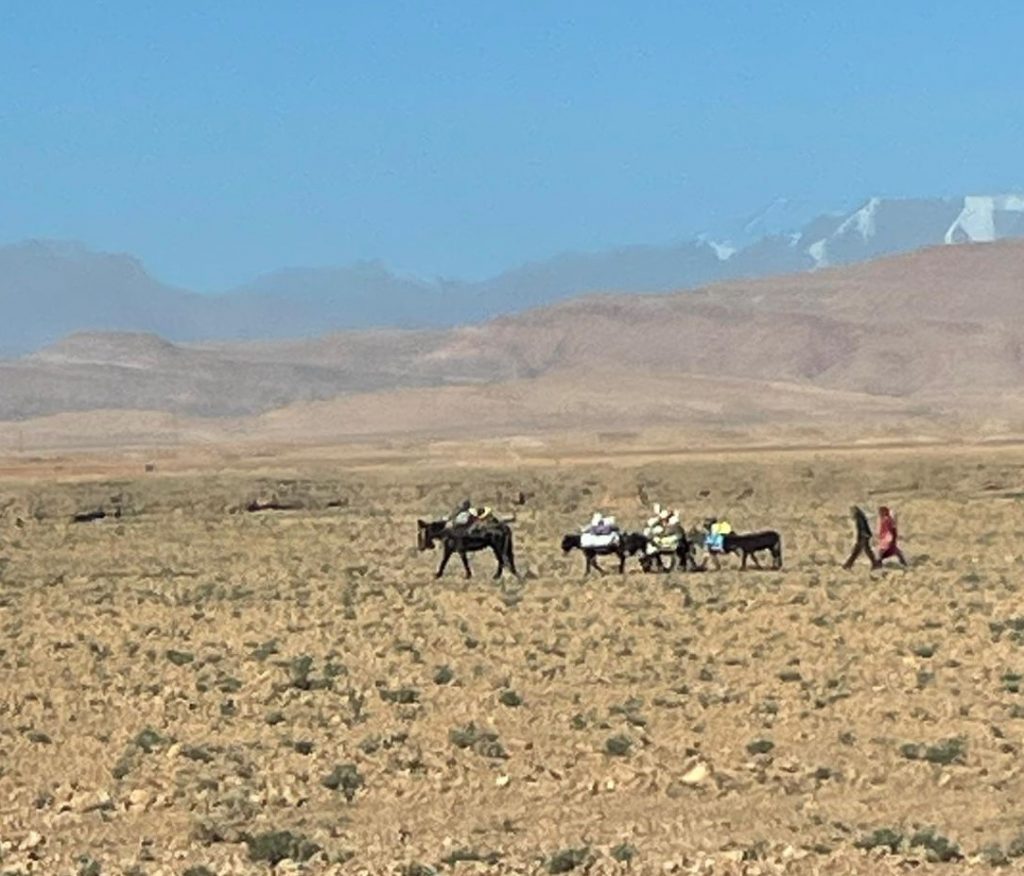
Pass through a village where a market is going on. Sheep in pick-up trucks, horses in horse boxes, sacks of produce. General chaos with traffic going in and out of parking lots. Lunch today is in a shopping mall. Not exactly thrilling but four of us find a pretty decent pasta dish in an Italian restaurant within.
Argan oil
The long drive resumes but it is a bit flatter and straighter as we come off the hills. On the final stretch towards the coast Argan trees, which produce oil, are plentiful. The bus stops at a cooperative where a lady informs us about the extraction process. At least, she endeavours to be informative. She speaks so fast I can barely catch a word. Anyway, I gather that the outer shells of the nuts are for goats, which are known to climb the trees to plunder them; the inner shells make firewood and the seeds produce oil for cooking and cosmetics.
Apparently southern Morocco is the only place in the world where Argan trees grow and the oil is in great demand, despite the fact that the price has risen due to the last six years of drought. Lady guide squirts a drop of the liquid gold onto each of our willing palms. Pleasant odour. And it is an effective oil against aging. Good to know. The cooking oil is darker and, mixed with honey and almonds, makes ‘Nutella’, a rich sweet Moroccan treat!
Argan oil is a good source of income for the rural population around here, especially women. Some of these local women dressed in blue coats and sitting cross-legged upon the floor, burst into song, a high pitched cheerful chant, when they see our group. All part of their marketing process no doubt. They shell the nuts from big baskets. They seem happy in their work.
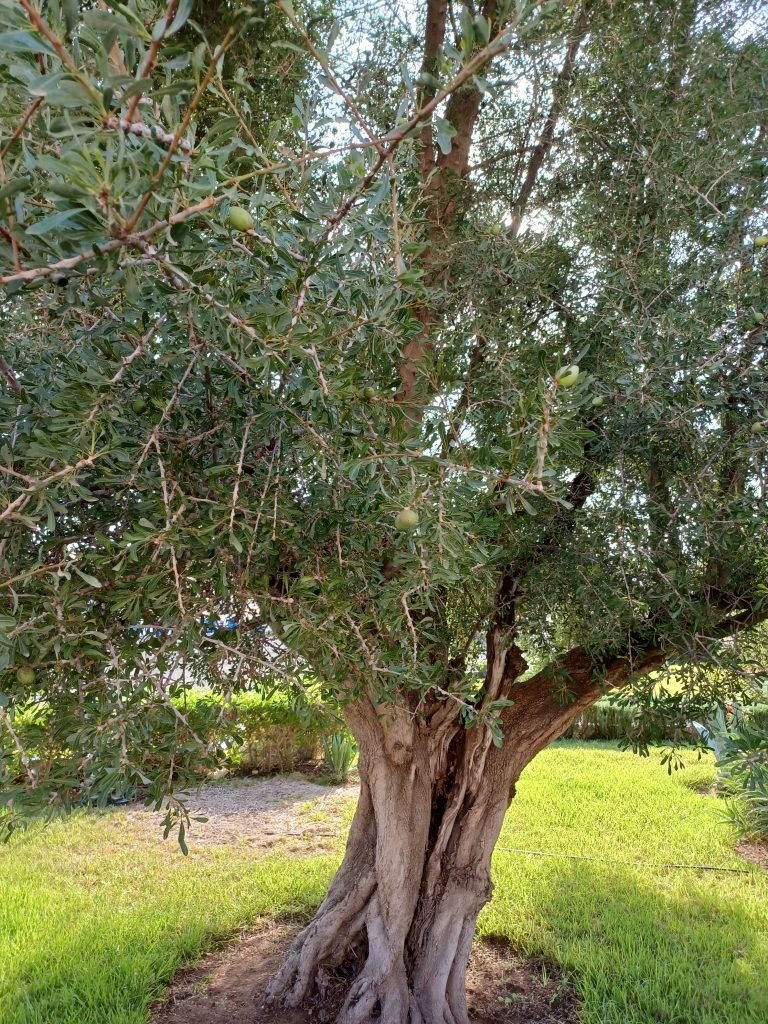
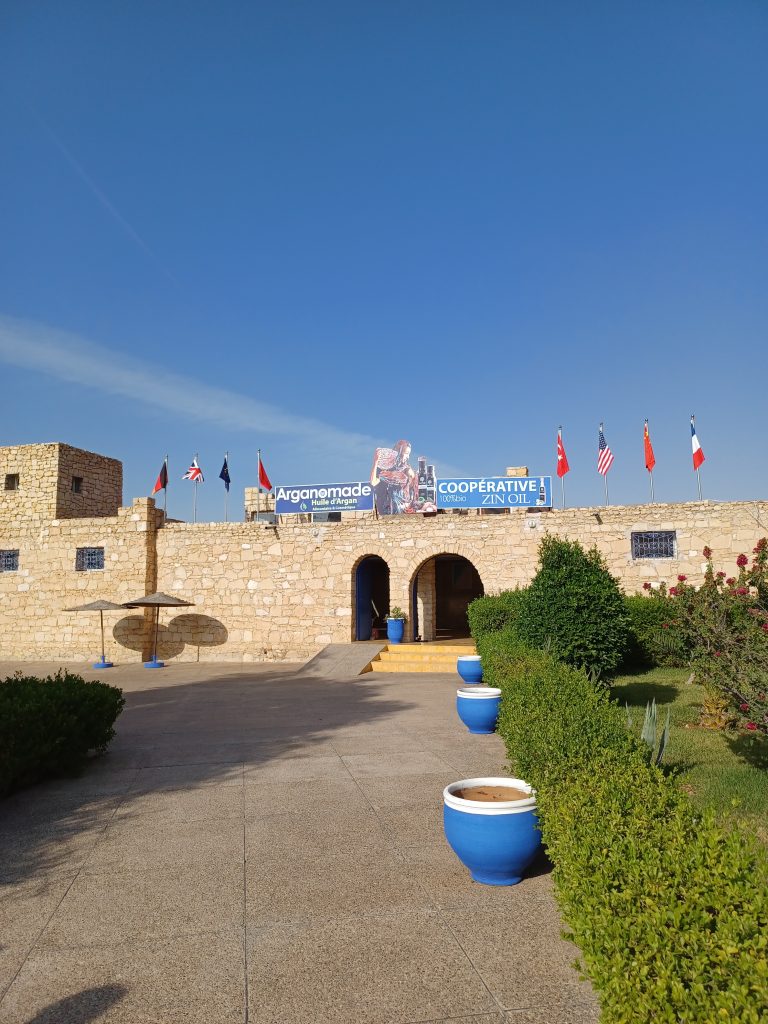
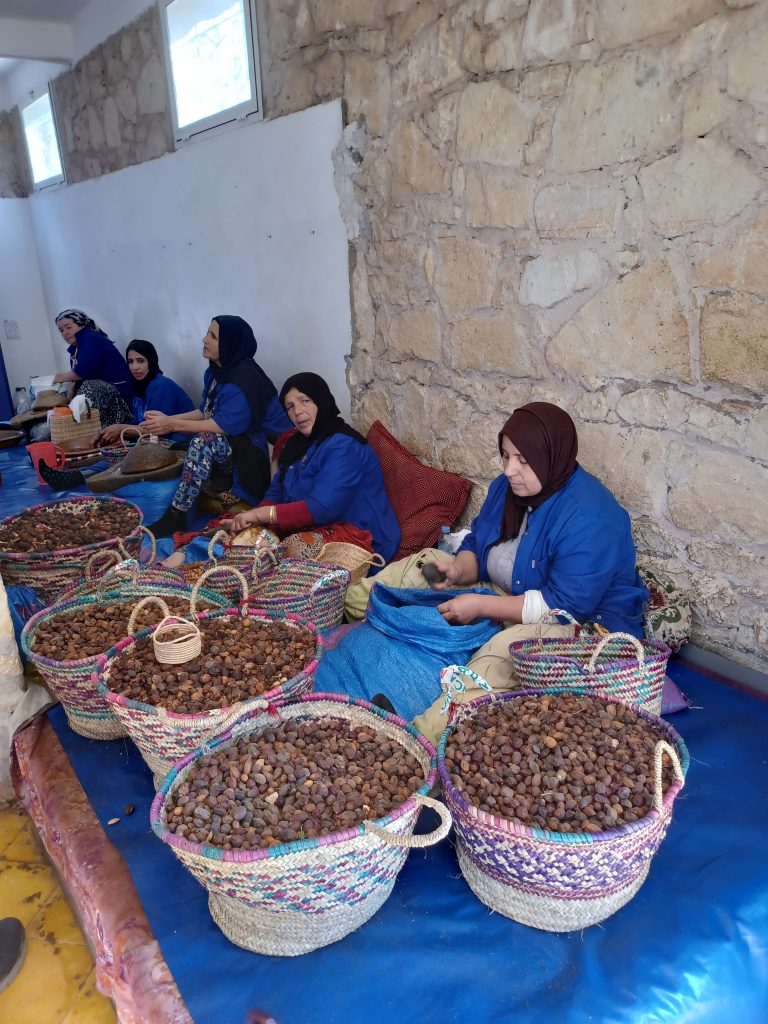
Essaouira
Arrive at the coastal town of Essaouira shattered. After a quick orientation tour, we explore the precincts of the old castle walls. Characterful place. Cannons poke out of crenallations overlooking the Atlantic. Wander towards the old harbour. Reeks of fish. Full of fishermen and their boats, and fish stalls with eels and stingrays and gulls flitting about between them.
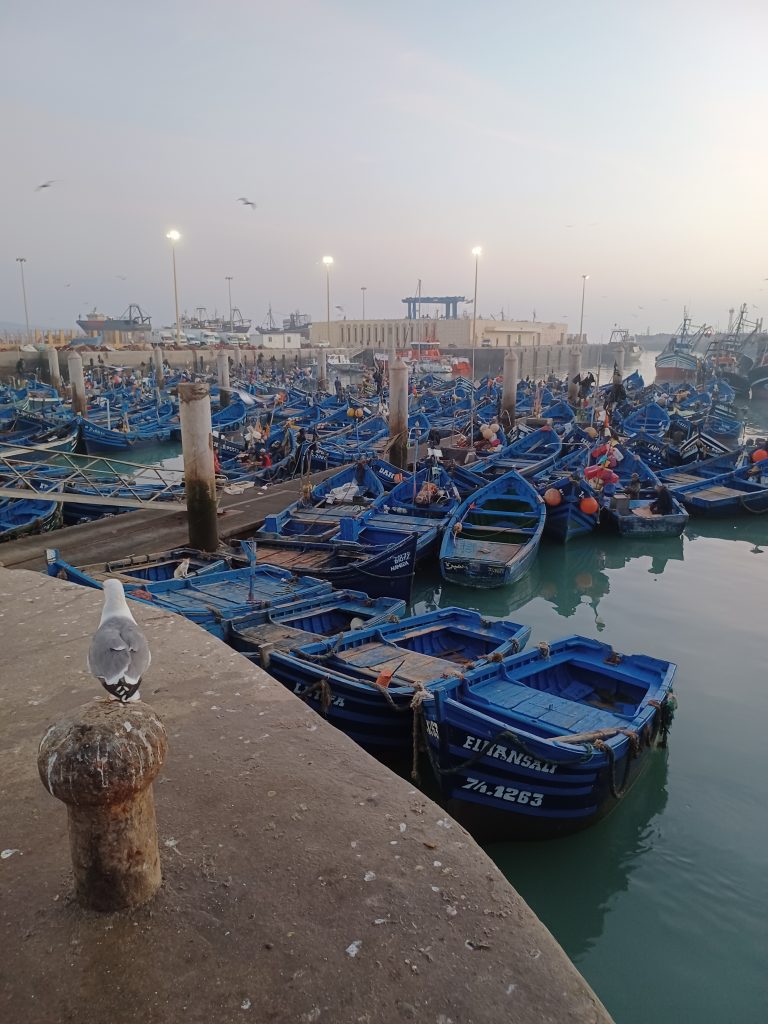
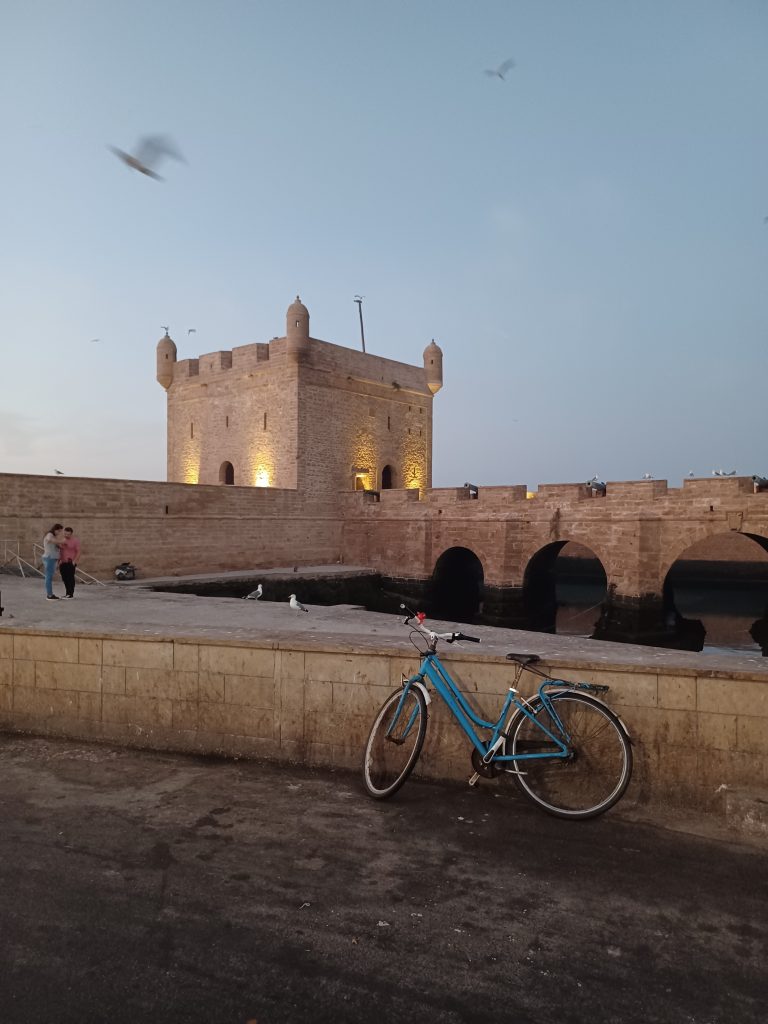
Later walk along the long sandy beach in front of the hotel. There is an island in the distance with two sailing ships anchored off. All is calm. A string of camels lollops along, a couple of horses gallop across the sands in the low sun’s rays and gulls paddle, leaving their webprints in the sand. Lovely restaurant overlooking the beach. Wine and things.
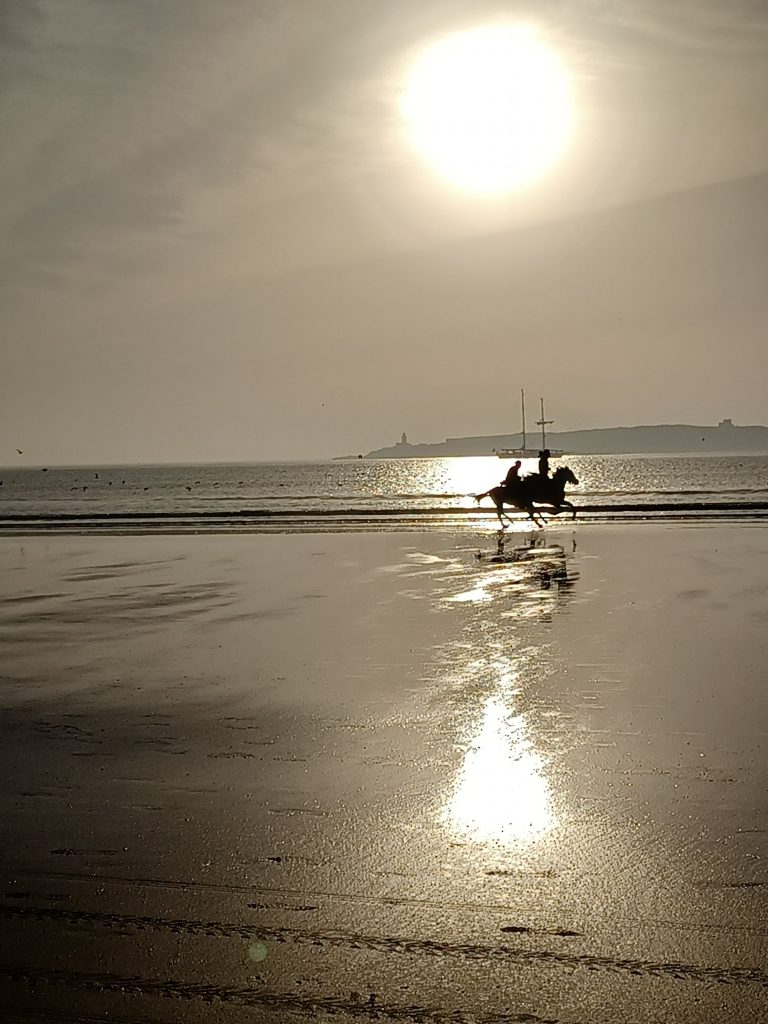
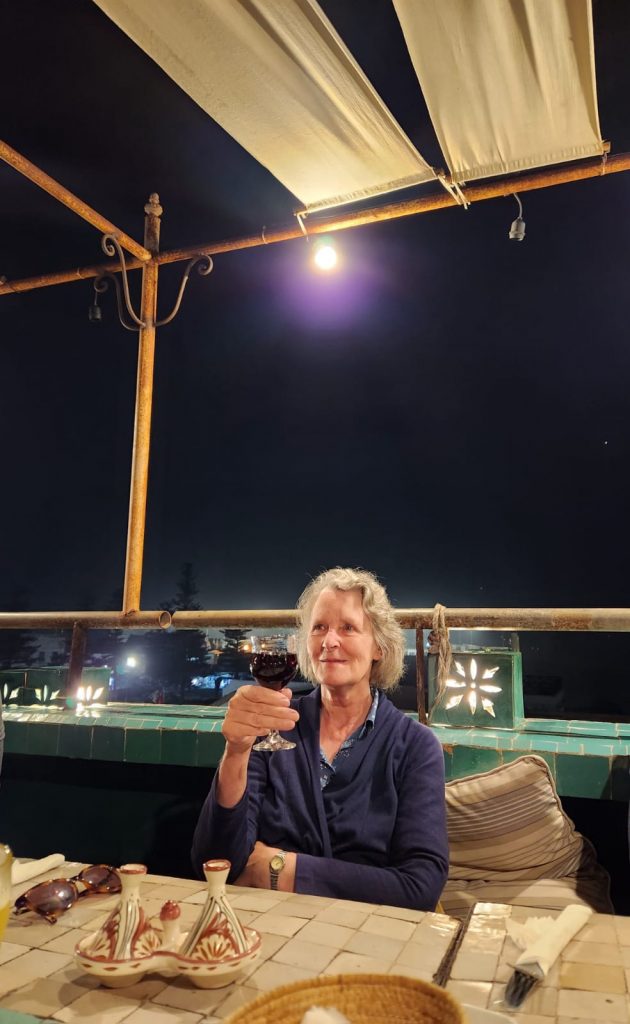
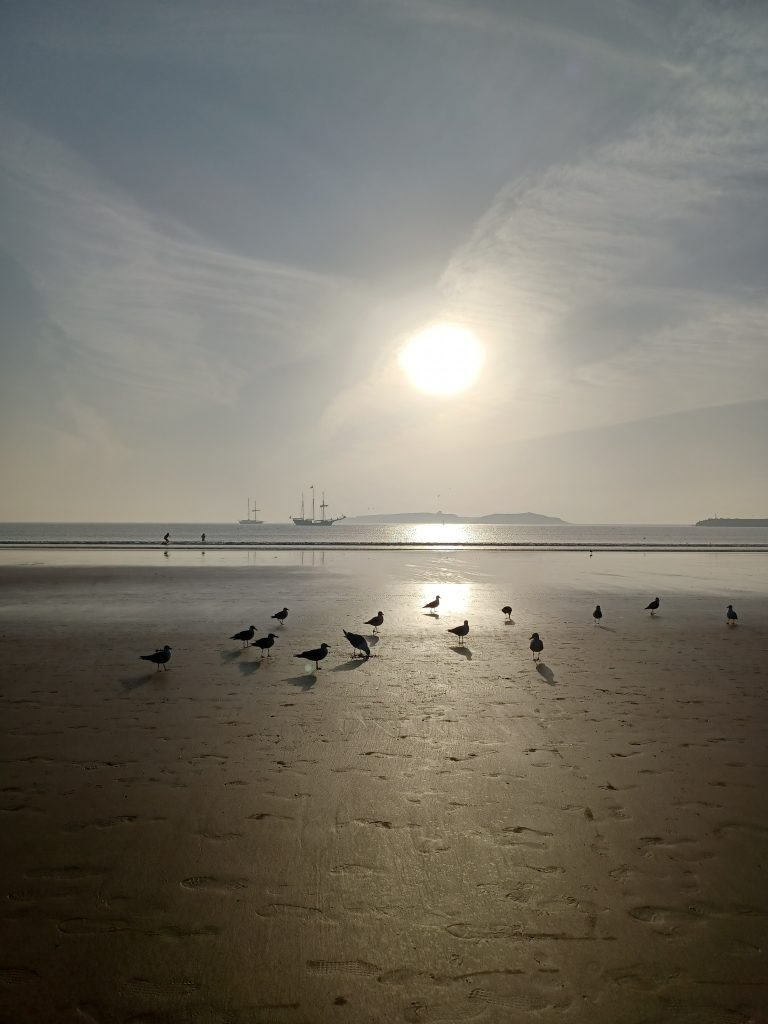
We have a whole day to explore the lovely town. Spend time ambling round similar slender alleyways as we have witnessed elsewhere, full of souvenirs, and drinking mint tea. Lunchtime finds us in an Asian restaurant for a rice dish as a spicy alternative to the now familiar Moroccan tagine and couscous. Some go for a massage with argan oil at the local hammam. I am sure they will derive benefit from it. Not me. I prefer to wander along the beach.
Much windier today. Kite surfers are flying along the wave tops. A man on a grey horse whizzes by. More camels. Wind in my hair, damp sand, gulls. Perfect.
My Moroccan adventure ends where it began. In Marrakech. Participants disperse. Some, like me, rent a riad for a day or three to rest and recuperate; others trickle slowly homewards. Verdict of tour: one of the best!

Leave a Reply